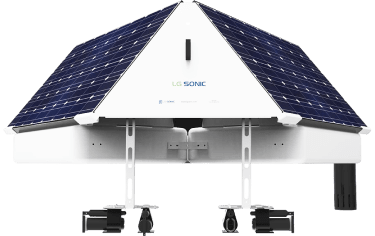LG Sonic contributes to the remediation of the Sellafield nuclear site
On the Sellafield site in Cumbria, nuclear materials have sat since 1947, initially employed in British nuclear weapon development. Later, Queen Elizabeth II inaugurated Calder Hall, the first nuclear power plant used for commercial purposes, in 1956. Now, the site is currently being shut down and cleaned up after more than 60 years of usage for nuclear operations.
Project summary
Environmental
remediation
Improved
fuel retrieval operations
Upgrade
to monitoring and control
Environmental remediation has gone nuclear
As activities end, the priority is shifting to remediating the site to make it safe for cleaning and a hazard-free environment for upcoming generations. The cleanup of the site’s spent fuel ponds and silos is one of the main difficulties involved with this task. One of these is an outdoor pond that frequently experiences algal blooms.
Algae disturbs water clarity
The Pile Fuel Storage Pond’s stagnant water and nutrient-rich water provided the ideal environment for algae to bloom (PFSP). The extensive algae bloom compromised the water’s purity, reducing underwater visibility, making it more difficult to carry out fuel collection operations in the pond. The site’s objective to provide risk reduction was hindered by poor visibility. Therefore, it is crucial to keep visibility high and carry out fuel retrieval operations.
Improving fuel retrieval operations
In the spring of 2018, pond visibility had almost completely vanished, forcing retrieval activities to be put on hold. During that summer, a number of LG Sonic Industrial Wet units were placed in the pond to help clear the water and allow retrieval activities to resume.
The amount of blue-green algae and chlorophyll significantly decreased after two weeks of using the LG Sonic ultrasonic algae control equipment. It was possible to view vessels and containers in the storage ponds that in previous years could only be seen when using an underwater mobile device because of the decreased algae levels, causing the water to clear.
Upgrade to monitoring and control
With the installation of the MPC-Grid, a new LG Sonic algal control unit, Sellafield and LG Sonic will expand their collaboration in the summer of 2022. A variant of the MPC-Buoy is the MPC-Grid, which uses grid electricity rather than solar power. Sellafield can obtain comprehensive information on the water quality, algae levels, and ultrasonic treatment process thanks to the unit’s water quality monitoring tools. LG Sonic’s use of ultrasound technology makes it possible to monitor and manage algae blooms without the use of chemicals. More than 55 nations throughout the world have benefitted from LG Sonic operations.
MPC-Buoy
All-in-one solution for controlling algae in large reservoirs.

